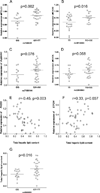SNPs affecting serum metabolomic traits may regulate gene transcription and lipid accumulation in the liver
- PMID: 22738862
- PMCID: PMC3867007
- DOI: 10.1016/j.metabol.2012.05.004
SNPs affecting serum metabolomic traits may regulate gene transcription and lipid accumulation in the liver
Abstract
Objective: Circulatory metabolites are important biomarkers for many diseases, especially metabolic disorders. The biological mechanism regulating circulatory levels of metabolites remains incompletely understood. Focusing on the liver as the central organ controlling metabolic homeostasis, we investigated the potential function of nine polymorphisms associated with serum metabolomic traits in a recent GWAS.
Materials/methods: The mRNA levels of the associated genes were measured by real-time PCR and correlated with genotypes in normal liver tissue (n=42). Genotype and mRNA data were also correlated with total hepatic lipid content (HLC). Our findings were also compared with the previously published gene expression quantitative traits loci (eQTL) data in the liver.
Results: We found that seven out of nine genes were highly expressed in hepatic tissue, while expression of four genes was significantly or marginally associated with genotypes (SPTLC3 vs rs168622, P=.002; ACADS vs rs2014355, P=.016; PLEKHH1 vs rs7156144, P=.076; ACADL vs rs2286963, P=.068). The SNP rs168622 at the SPTLC3 locus was also significantly correlated with HLC (P=.02). HLC was significantly correlated with FADS1 (r=-0.45; P=.003) and ETFDH (r=0.33; P=.037) expression. When compared with published eQTL data, SNPs in SPTLC3, ACADS, ELOVL2 and FADS1 were also in strong linkage disequilibrium (R(2)≥0.41, D'≥0.96) with eQTLs significantly affecting expression of these genes (P≤1.74×10(-5)).
Conclusions: Our study suggests that genetic variants affecting serum metabolites levels may play a functional role in the liver. This may help elucidate the mechanism by which genetic variants are involved in metabolic diseases.
Copyright © 2012 Elsevier Inc. All rights reserved.
Figures

References
-
- Smith BW, Adams LA. Nonalcoholic fatty liver disease and diabetes mellitus: pathogenesis and treatment. Nat Rev Endocrinol. 2011;7:456–465. - PubMed
Publication types
MeSH terms
Substances
Grants and funding
LinkOut - more resources
Full Text Sources

